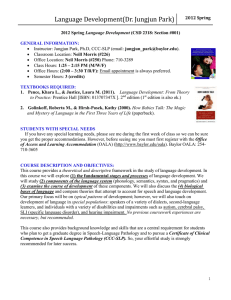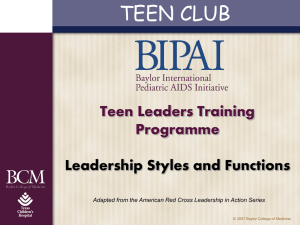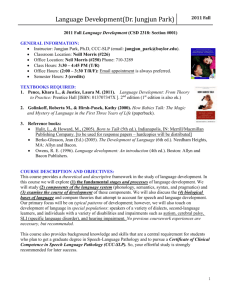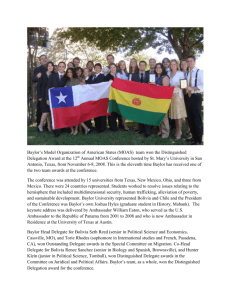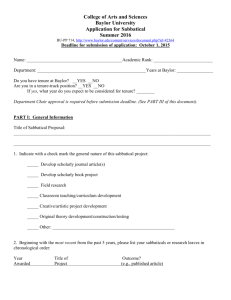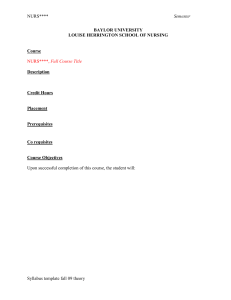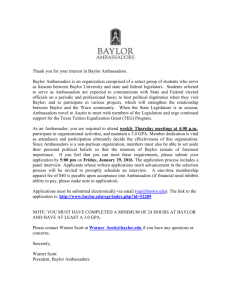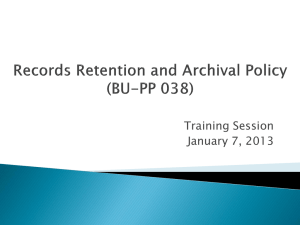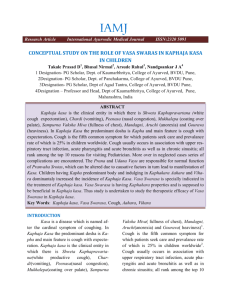Anatomy and Physiology of Speech and
advertisement
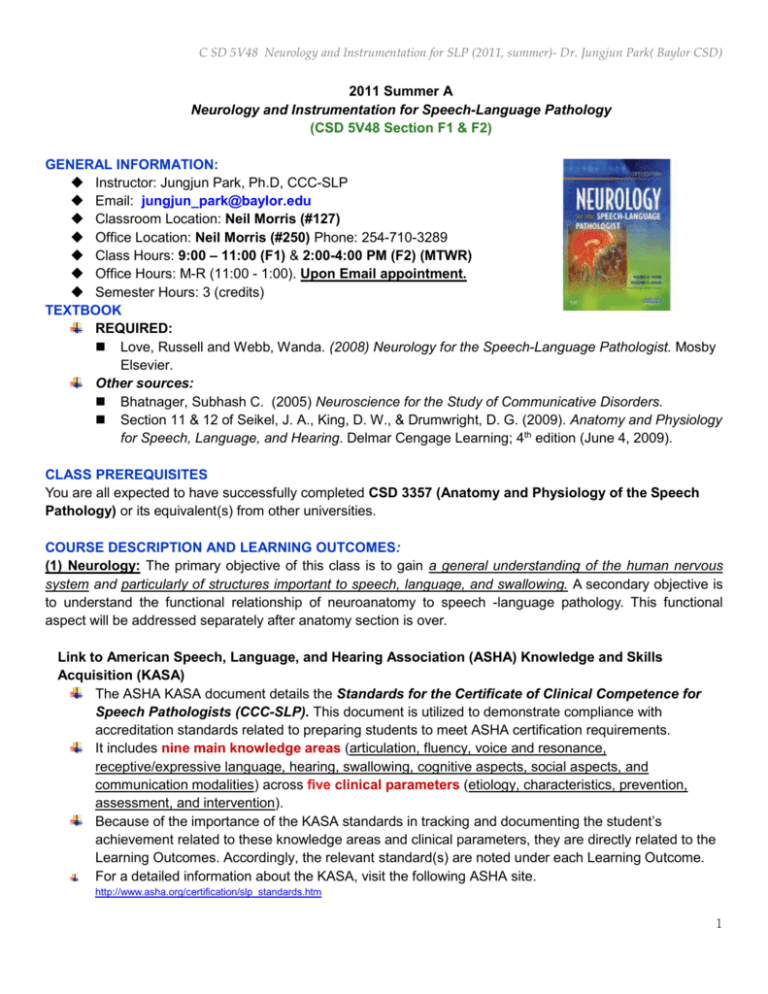
C SD 5V48 Neurology and Instrumentation for SLP (2011, summer)- Dr. Jungjun Park( Baylor CSD) 2011 Summer A Neurology and Instrumentation for Speech-Language Pathology (CSD 5V48 Section F1 & F2) GENERAL INFORMATION: Instructor: Jungjun Park, Ph.D, CCC-SLP Email: jungjun_park@baylor.edu Classroom Location: Neil Morris (#127) Office Location: Neil Morris (#250) Phone: 254-710-3289 Class Hours: 9:00 – 11:00 (F1) & 2:00-4:00 PM (F2) (MTWR) Office Hours: M-R (11:00 - 1:00). Upon Email appointment. Semester Hours: 3 (credits) TEXTBOOK REQUIRED: Love, Russell and Webb, Wanda. (2008) Neurology for the Speech-Language Pathologist. Mosby Elsevier. Other sources: Bhatnager, Subhash C. (2005) Neuroscience for the Study of Communicative Disorders. Section 11 & 12 of Seikel, J. A., King, D. W., & Drumwright, D. G. (2009). Anatomy and Physiology for Speech, Language, and Hearing. Delmar Cengage Learning; 4th edition (June 4, 2009). CLASS PREREQUISITES You are all expected to have successfully completed CSD 3357 (Anatomy and Physiology of the Speech Pathology) or its equivalent(s) from other universities. COURSE DESCRIPTION AND LEARNING OUTCOMES: (1) Neurology: The primary objective of this class is to gain a general understanding of the human nervous system and particularly of structures important to speech, language, and swallowing. A secondary objective is to understand the functional relationship of neuroanatomy to speech -language pathology. This functional aspect will be addressed separately after anatomy section is over. Link to American Speech, Language, and Hearing Association (ASHA) Knowledge and Skills Acquisition (KASA) The ASHA KASA document details the Standards for the Certificate of Clinical Competence for Speech Pathologists (CCC-SLP). This document is utilized to demonstrate compliance with accreditation standards related to preparing students to meet ASHA certification requirements. It includes nine main knowledge areas (articulation, fluency, voice and resonance, receptive/expressive language, hearing, swallowing, cognitive aspects, social aspects, and communication modalities) across five clinical parameters (etiology, characteristics, prevention, assessment, and intervention). Because of the importance of the KASA standards in tracking and documenting the student’s achievement related to these knowledge areas and clinical parameters, they are directly related to the Learning Outcomes. Accordingly, the relevant standard(s) are noted under each Learning Outcome. For a detailed information about the KASA, visit the following ASHA site. http://www.asha.org/certification/slp_standards.htm 1 C SD 5V48 Neurology and Instrumentation for SLP (2011, summer)- Dr. Jungjun Park( Baylor CSD) (2) Instrumentation: Text: No text is required, but you can use the texts that were used for speech science, anatomy and physiology, and/or voice disorder. It is encouraged that you also get related materials from various sources such as freely accessible websites related to vocal pathology, voice care, anatomy, and acoustic analyses. Objectives: Build a basic knowledge and skills of speech and language instrumentation. Introduction to state-of-the-art methods and techniques in the field of voice care, such as videostroboscopy, transnasal fiberoptic endoscopy, various acoustic measures/analyses (CSL-computerized speech lab), and language analyses. 50% of lectures plus 50% of laboratory meetings Lectures: the basics of laryngeal structure, hierarchy of speech chain formation (motor programming through ultimate speech production), basic speech science (acoustic measures/analyses/interpretation), voice quality, pathophysiological characteristics of disorderly voice, etc. Lab: voice lab, videostroboscopy lab, etc. Learning outcome 1. The student will review basic information about neuroanatomy, neurophysiology, and the organization of the motor and sensory systems. a. KASA Standard III-B: The student must demonstrate knowledge of basic human communication processes (neurological, acoustic) 2. The student will acquire knowledge and understanding of the neural correlates of language function. a. KASA Standard III-C i. The student must demonstrate knowledge of receptive and expressive language in speaking, listening, reading, writing, and manual modalities. ii. The student must demonstrate knowledge of cognitive aspects of communication (attention, memory, sequencing, problem-solving, executive functioning). 3. Identify the anatomical structures of the central and peripheral nervous system and discuss their functional role: KASA Standards III-A, B 4. Describe the physiological functions of the structures of the central and peripheral nervous system : KASA Standards III-A, B. Baylor Blackboard: Syllabus, lecture notes, videos, handouts, and announcements will be posted on the Blackboard. ACADEMIC INTEGRITY Students in this course are expected to firmly abide by the Baylor University Student Honor Code as outlined in the Student Handbook. Students who violate the Honor Code will suffer the consequences: Any evidence of dishonorable conduct (i.e., cheating in and out of the class for class activities such as exams, assignments) as outlined in the Baylor Honor Code will result in an "F" (http://www.baylor.edu/honorcode/index.php?id=44060). 2 C SD 5V48 Neurology and Instrumentation for SLP (2011, summer)- Dr. Jungjun Park( Baylor CSD) COURSE REQUIREMENTS AND ORGANIZATION 1) Class participation a. Attendance: Students are expected to attend all class sessions. Baylor requirement, a minimum attendance for 75% of all sessions, is required to receive any grade. (http://www.baylor.edu/student%5Fpolicies/index.php?id=22214) b. Any student who misses a class (or any portion of class) has the responsibility for obtaining copies of notes, handouts, assignments, changes to the schedule of topics, activities/assignments, i.e., all of the content covered in class (including any changes). c. Contact the instructor through email prior to class if you are unable to attend and want to provide a reason for your absence. d. If you are absent on the day of an examination and/or due assignment, an explanation of the absence and a legitimate excuse consists of a doctor’s note due to your illness, documented family emergency. Other excuses may be considered legitimate at the instructor’s discretion. 2) Evaluation and Dates: 4 weekly quizzes, 1 comprehensive final, lab assignments, and the portfolio. a. Exam/quizzes (700 pts) o Sources: slides, class lectures o Format: multiple choice, true/false, fill-in-the-blank, anatomical labeling, and short answer. o Scoring criterion Quiz: Each quiz has a max score of 100 (total of 400). Exam: The final comprehensive exam has a possible score of 300. University Final Exam: 9-11 AM or 2-4 PM (July, 6) http://www.baylor.edu/calendar/index.php?id=7933&day=2011-07-01&type=month&t=all b. Lab assignments (200 pts): Every lab assignment should be turned in on the designated due day. c. Course portfolio (100 pts): Due by June 30 PM 5 (Last class day) – returned by July 1 (Friday) o The course portfolio will be your own personal handbook to help you in your career after you have completed the course. o The portfolio must include all of the PPT slides, assignments, quizzes, hand-outs, and additional study materials created/collected by you (For efficient learning of brain anatomy, you will need to seek for a wide range of website information throughout the semester!) o Organize your portfolio into several related sections and prepare labeled dividers for each section. 3) Grading Policy: Final grades will be determined according to the following scale. Grade Actual point range (out of 100) %-ile A+ 95.0 - 100% 950 – 1000 A 90.0 – 94.99% 900 – 949.9 B+ 85.0 – 89.99% 850 – 899.9 B 80.0 - 84.99% 800 – 849.9 C+ 75.0 – 79.99% 750 – 799.9 C 70.0 – 74.99% 700 – 749.9 D+ 65.0 – 69.99% 650 – 699.9 D 60.0 – 65.99% 600 – 659.9 F Below 60.0% Below 600.0 3 C SD 5V48 Neurology and Instrumentation for SLP (2011, summer)- Dr. Jungjun Park( Baylor CSD) Course content (neurology) **Actual order of contents is subject to changes. Section 1: Overview: Basics of the Nervous System Section 2: Overview: General Description of the Central Nervous System Section 3: Meninges and Cerebrospinal Fluid Section 4: Cerebral Cortex (gyrus, sulcus, surface of the brain), Brodmann's Classification System Section 5: Corpus Striatum, Connecting Fibers Section 6: Midbrain, Pons, Medulla, and Reticular Formation Section 7: Spinal cord, Spinal nerves, and Cerebellum Section 8: Cranial Nerves Section 9: Limbic system Section 10: Motor Neuronal Tracts (Motor Pathway for Speech): Corticobulbar, Corticospinal, Reticular tracts Section 11: Blood Supply to the Brain Section 12: Neurochemistry Section 13: Neuroanatomical bases and neuroscientific models of Language, Reading (Literacy) Section 14: Neuroanatomical bases and neuroscientific models of Speech Production Course content (instrumentation) o o o o o Quick review of larynx anatomy: Theoretical overview of laryngeal anatomy and physiology in preparation of videostroboscopy lab practice Major speech acoustic parameters of clinical use Review of basic speech science related to clinical instrumentation Clinical use of acoustic parameters EMST (external muscle strength training): Respiration for speech (Parkinson’s Dz) Software laboratory (Praat lab plus Kay Pentax CSL lab in the 1st floor lab) In-class software: Praat (freeware: PC & Mac) http://www.fon.hum.uva.nl/praat/download_win.html Videostroboscopy lab: Dr. David J. Garrett (Guest Voice Scientist) Tip: Use the websites in the Blackboard, Study Guide for each section, and PDF files (ppt). 4
